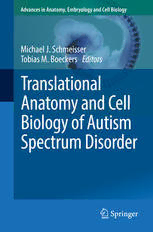Table Of ContentAdvances in Anatomy, Embryology and Cell Biology
Michael J. Schmeisser
Tobias M. Boeckers Editors
Translational
Anatomy and Cell
Biology of Autism
Spectrum Disorder
AdvancesinAnatomy,EmbryologyandCellBiologypublishescriticalreviewsandstate-of-
the-art surveys on all aspects of anatomy and of developmental, cellular and molecular
biology,withaspecialemphasisonbiomedicalandtranslationaltopics.
Theseriespublishesvolumesintwodifferentformats:
(cid:129)Contributedvolumes,eachcollecting5to15focusedreviewswrittenbyleadingexperts
(cid:129) Single-authored or multi-authored monographs, providing a comprehensive overview of
theirtopicofresearch
Manuscriptsshouldbeaddressedto
Co-ordinatingEditor
Prof.Dr.H.-W.KORF,ZentrumderMorphologie,Universita¨tFrankfurt,Theodor-SternKai7,
60595Frankfurt/Main,Germany
e-mail:[email protected]
Editors
Prof.Dr.T.M.BOECKERS,Institutfu¨rAnatomieundZellbiologie,Universita¨tUlm,Ulm,Germany
e-mail:[email protected]
Prof.Dr.F.CLASCA´,DepartmentofAnatomy,HistologyandNeurobiology
UniversidadAuto´nomadeMadrid,Ave.ArzobispoMorcillos/n,28029Madrid,Spain
e-mail:[email protected]
Prof.Dr.Z.KMIEC,DepartmentofHistologyandImmunology,MedicalUniversityofGdansk,
Debinki1,80-211Gdansk,Poland
e-mail:[email protected]
Prof.Dr.B.SINGH,WesternCollegeofVeterinaryMedicine,UniversityofSaskatchewan,Saskatoon,SK,Canada
e-mail:[email protected]
Prof.Dr.P.SUTOVSKY,S141AnimalScienceResearchCenter,UniversityofMissouri,Columbia,MO,USA
e-mail:[email protected]
Prof.Dr.J.-P.TIMMERMANS,DepartmentofVeterinarySciences,UniversityofAntwerpen,
Groenenborgerlaan171,2020Antwerpen,Belgium
e-mail:[email protected]
224
Advances in Anatomy,
Embryology
and Cell Biology
Co-ordinatingEditor
H.-W.Korf,Frankfurt
SeriesEditors
T.M.Boeckers(cid:129)F.Clasca´ (cid:129)Z.Kmiec
B.Singh(cid:129)P.Sutovsky(cid:129)J.-P.Timmermans
More information about this series at
http://www.springer.com/series/102
Michael J. Schmeisser (cid:129)
Tobias M. Boeckers
Editors
Translational
Anatomy and Cell
Biology of Autism
Spectrum Disorder
Editors
MichaelJ.Schmeisser TobiasM.Boeckers
InstituteforAnatomyandCellBiology InstituteforAnatomyandCellBiology
UlmUniversity UlmUniversity
Ulm,Germany Ulm,Germany
DivisionofNeuroanatomy
InstituteofAnatomy
Otto-von-GuerickeUniversity
Magdeburg,Germany
LeibnizInstituteforNeurobiology
Magdeburg,Germany
ISSN0301-5556 ISSN2192-7065 (electronic)
AdvancesinAnatomy,EmbryologyandCellBiology
ISBN978-3-319-52496-2 ISBN978-3-319-52498-6 (eBook)
DOI10.1007/978-3-319-52498-6
LibraryofCongressControlNumber:2017942780
©SpringerInternationalPublishingAG2017
Thisworkissubjecttocopyright.AllrightsarereservedbythePublisher,whetherthewholeorpartof
the material is concerned, specifically the rights of translation, reprinting, reuse of illustrations,
recitation, broadcasting, reproduction on microfilms or in any other physical way, and transmission
or information storage and retrieval, electronic adaptation, computer software, or by similar or
dissimilarmethodologynowknownorhereafterdeveloped.
The use of general descriptive names, registered names, trademarks, service marks, etc. in this
publicationdoesnotimply,evenintheabsenceofaspecificstatement,thatsuchnamesareexempt
fromtherelevantprotectivelawsandregulationsandthereforefreeforgeneraluse.
Thepublisher,theauthorsandtheeditorsaresafetoassumethattheadviceandinformationinthis
book are believed to be true and accurate at the date of publication. Neither the publisher nor the
authors or the editors give a warranty, express or implied, with respect to the material contained
hereinor for anyerrors oromissionsthat may havebeenmade. Thepublisher remainsneutralwith
regardtojurisdictionalclaimsinpublishedmapsandinstitutionalaffiliations.
Printedonacid-freepaper
ThisSpringerimprintispublishedbySpringerNature
TheregisteredcompanyisSpringerInternationalPublishingAG
Theregisteredcompanyaddressis:Gewerbestrasse11,6330Cham,Switzerland
Preface
Autismspectrumdisorder(ASD)isacomplexandheterogeneousneurodevelopmental
condition clinically defined by a core symptomatology including an impairment of
socialinteractionandcommunicationandthepresenceofrestricted,repetitivebehav-
iours. In addition, individuals with ASD can suffer from a variety of comorbidities
rangingfromintellectualdisabilitytoepilepsyandgastrointestinaldysfunction.
Withaprevalenceofapproximately1%,andonlyfewtherapeuticoptionsthus
far,ASDhasbecomeanincreasingburdenforoursociety.Importantly,researchon
ASD—ongoing since its first description in the literature in the 1940s—has made
major advances throughout the last decade with the discovery of defined genetic
mutationsinaffectedindividuals.Consideringthefactthatthesemutationscanbe
studied in modelsystems including cell culture and genetically modified animals,
firsthypothesesaboutthecellularandmolecularunderpinningsofASDhavebeen
emerging. As many of the so-called ASD genes encode proteins essentially
involved in the development of neural circuits and excitatory synapses and the
observation that corresponding model systems often show neural circuit and syn-
aptic dysfunction, it can be stated that ASD might derive from an aberrant devel-
opment of brain circuitry. However, we are still at the very beginning of
understanding the nature of ASD, and focused research is needed in the years to
cometouncoverunderlyingmechanismsandtranslatethesefindingsfrombenchto
bedsidetofurtherdevelopeffectivetreatments.
Thisspecialvolumeintendstoprovideastate-of-the-artinsightintotranslational
ASD research with a special focus on anatomy and cell biology. International
experts from the field including several members of the EU-AIMS programme
launchedbytheInnovativeMedicinesInitiativeoftheEuropeanUniontodevelop
newmedicationsforASDhavecontributedchaptersonallaspectsoftranslational
ASD research. These include reviews on human genetics, human anatomy, stem
cell-derived cellular models and a whole variety of animal models. Overall, their
primary objective is to clarify how the identification of anatomical and cell
v
vi Preface
biologicalphenotypesofASDinbothhumansandtheappropriatemodelsystems
will help to translate basic mechanisms to clinical practice and efficiently treat
affectedindividualsinthefuture.
UlmandMagdeburg,Germany MichaelJ.Schmeisser
Ulm,Germany TobiasM.Boeckers
Contents
1 AnatomyandCellBiologyofAutismSpectrumDisorder:Lessons
fromHumanGenetics. . . . . . . . . . . . . . . . . . . . . . . . . . . . . . . . . . . 1
KristelT.E.Kleijer,GuillaumeHuguet,JulieTastet,ThomasBourgeron,
andJ.P.H.Burbach
2 NeuroanatomyandNeuropathologyofAutismSpectrumDisorder
inHumans. . . . . . . . . . . . . . . . . . . . . . . . . . . . . . . . . . . . . . . . . . . 27
ChristineEcker,MichaelJ.Schmeisser,EvaLoth,
andDeclanG.Murphy
3 ModellingAutisticNeuronswithInducedPluripotentStem
Cells. . . . . . . . . . . . . . . . . . . . . . . . . . . . . . . . . . . . . . . . . . . . . . . . 49
AnnieKathuria,CarloSala,ChiaraVerpelli,andJackPrice
4 ModellingAutisticFeaturesinMiceUsingQuantitativeGenetic
Approaches. . . . . . . . . . . . . . . . . . . . . . . . . . . . . . . . . . . . . . . . . . . 65
RemcoT.Molenhuis,HilgoBruining,andMartienJ.Kas
5 BehaviouralPhenotypesandNeuralCircuitDysfunctionsinMouse
ModelsofAutismSpectrumDisorder. . . . . . . . . . . . . . . . . . . . . . . 85
Allain-ThibeaultFerhat,SonjaHalbedl,MichaelJ.Schmeisser,
MartienJ.Kas,ThomasBourgeron,andElodieEy
6 CerebellarandStriatalPathologiesinMouseModelsofAutism
SpectrumDisorder. . . . . . . . . . . . . . . . . . . . . . . . . . . . . . . . . . . . . 103
SasˇaPeter,ChrisI.DeZeeuw,TobiasM.Boeckers,
andMichaelJ.Schmeisser
7 NeurotrophicFactorsinMouseModelsofAutismSpectrum
Disorder:FocusonBDNFandIGF-1. . . . . . . . . . . . . . . . . . . . . . . 121
DominikReimandMichaelJ.Schmeisser
vii
viii Contents
8 TheRoleoftheOxytocin/ArginineVasopressinSysteminAnimal
ModelsofAutismSpectrumDisorder. . . . . . . . . . . . . . . . . . . . . . . 135
RongZhang,Xin-JieXu,Hong-FengZhang,Song-PingHan,
andJi-ShengHan
9 ExtracerebralDysfunctioninAnimalModelsofAutismSpectrum
Disorder. . . . . . . . . . . . . . . . . . . . . . . . . . . . . . . . . . . . . . . . . . . . . 159
ElisaL.Hill-Yardin,SonjaJ.McKeown,GaiaNovarino,
andAndreasM.Grabrucker
10 GeneticandPharmacologicalReversibilityofPhenotypesinMouse
ModelsofAutismSpectrumDisorder. . . . . . . . . . . . . . . . . . . . . . . 189
JanC.Schroeder,ElenaDeliu,GaiaNovarino,
andMichaelJ.Schmeisser
Chapter 1
Anatomy and Cell Biology of Autism
Spectrum Disorder: Lessons from Human
Genetics
KristelT.E.Kleijer,GuillaumeHuguet,JulieTastet,ThomasBourgeron,
andJ.P.H.Burbach
1.1 Introduction
Autismspectrumdisorder(ASD)describesagroupofneurodevelopmentalcondi-
tionsclinicallycharacterisedbyimpairedsocialinteractionandcommunicationand
the presence of restricted interests and stereotyped and repetitive behaviours
(Kanner 1943; Asperger 1944; Coleman and Gillberg 2012). Epidemiological
studies estimate that more than 1% of the general population could receive a
diagnosis of ASD (Elsabbagh et al. 2012; Developmental Disabilities Monitoring
K.T.E.Kleijer(cid:129)J.Tastet(cid:129)J.P.H.Burbach(*)
DepartmentofTranslationalNeuroscience,BrainCenterRudolfMagnus,UniversityMedical
CenterUtrecht,Utrecht,TheNetherlands
e-mail:[email protected]
G.Huguet
HumanGeneticsandCognitiveFunctions,InstitutPasteur,Paris,France
CNRSUMR3571Genes,SynapsesandCognition,InstitutPasteur,Paris,France
HumanGeneticsandCognitiveFunctions,UniversityParisDiderot,SorbonneParisCite´,
Paris,France
T.Bourgeron
HumanGeneticsandCognitiveFunctions,InstitutPasteur,Paris,France
CNRSUMR3571Genes,SynapsesandCognition,InstitutPasteur,Paris,France
HumanGeneticsandCognitiveFunctions,UniversityParisDiderot,SorbonneParisCite´,
Paris,France
FondaMentalFoundation,Cre´teil,France
GillbergNeuropsychiatryCentre,SahlgrenskaAcademy,UniversityofGothenburg,
Gothenburg,Sweden
©SpringerInternationalPublishingAG2017 1
M.J.Schmeisser,T.M.Boeckers(eds.),TranslationalAnatomyandCellBiologyof
AutismSpectrumDisorder,AdvancesinAnatomy,EmbryologyandCellBiology
224,DOI10.1007/978-3-319-52498-6_1

